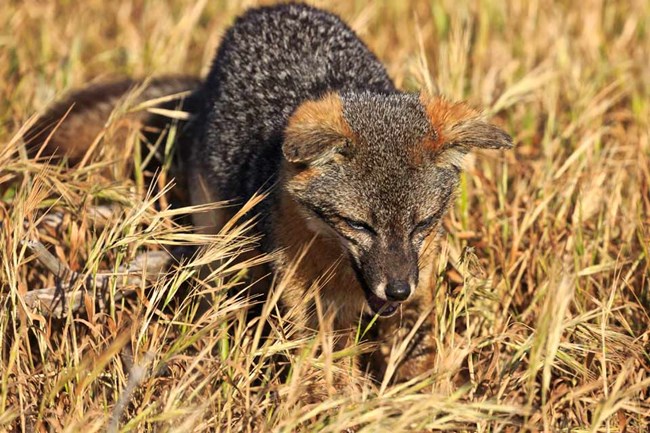
Overview | Restoration | Current Status
Park biologists estimated there to be over 400 foxes on San Miguel in 1994, but by 1995, an alarming decline had begun. With each passing year, fewer foxes were trapped in the monitoring grids. At the same time, rangers and visitors reported seeing fewer live foxes and more fox skeletons and carcasses. By 1998, the San Miguel population was down to a few dozen. Island fox populations on all three islands were naturally small and had historically fluctuated, but as far as was known had never been as low as they were during this period and had never come close to extinction. In fall 1998, National Park Service biologists initiated a radio telemetry study of island foxes on San Miguel Island to determine causes of mortality. Of 15 radio collared foxes tracked from 1998 to 1999, 5 were believed to be killed by golden eagles and 2 died of other causes. This confirmed the results of an earlier study on Santa Cruz Island where golden eagle predation was identified as the cause of death for 21 of 29 fox carcasses. Golden eagle predation was unprecedented, and was considered unnatural because golden eagles had not previously bred on the islands and were, until this time, rarely observed. Similar declines occurred simultaneously in the island fox populations on neighboring Santa Rosa and Santa Cruz Islands Fox mortality rates due to predation were so high that by 1999 the San Miguel and Santa Rosa fox subspecies were nearing extinction; on each of those islands total abundance had declined from approximately 450 and 1,500, respectively, to 15. Eliminating the Major Cause for Decline Interestingly, the first documented decline on San Miguel in 1995 coincided with the first golden eagle sightings on the island. Golden eagles had been live-captured and relocated from some areas in western North America to reduce depredation on livestock and it was surmised that similar translocation methods could be used to golden eagles from the Channel Islands. In late 1999 the National Park began working with its partners to relocate golden eagles to the mainland. Golden eagles nested on both Santa Cruz and Santa Rosa Islands from the mid-1990s to as recently as 2006. In order to mitigate golden eagle predation on island foxes, The Santa Cruz Predatory Bird Research Group, with the support of the Park Service and The Nature Conservancy, trapped and relocated a total of 44 golden eagles, including 10 eaglets born on the islands to distant sites in northeastern California. Monitoring indicated that , none returned to the islands.5 Today the occasional golden eagle visits the islands, but the level of predation on island foxes is negligible; all three island fox subspecies in the park are recovering rapidly. Additional Threats Due to their insular existence, island foxes have no built up immunity to parasites and diseases brought in from the mainland and are especially vulnerable to those a domestic dog might be carrying. In addition, it is extremely difficult to vaccinate against or treat foxes for these parasites and diseases in the wild. For this reason, pets are not permitted in Channel Islands National Park. Eliminating Other Factors Contributing to the Decline Simply relocating the existing golden eagles would not assure island fox recovery. With the substantial prey base provided by island pigs, dispersing golden eagles would continue to breed on the island. It would therefore be necessary to implement longer-term actions that would prevent sustained use of the islands by golden eagles. This resulted in a strategy that would require the removal of the feral pigs on Santa Cruz Island beginning in 2004, in a project implemented by the NPS and The Nature Conservancy, its partner in management of Santa Cruz Island. By 2006, no pigs remained on Santa Cruz Island. In a similar manner, introduced mule deer supported golden eagle breeding on neighboring Santa Rosa Island. Deer and elk on that island were to be phased out as part of an agreement between NPS and the former owners of the island, and by 2012 non-native ungulates had been all but eliminated on Santa Rosa Island.
Visit our keyboard shortcuts docs for details
Close to the mainland yet worlds apart, Santa Cruz Island is home to plants and animals that are found nowhere else on Earth. The introduction of of non-native, exotic plants and animals have caused the loss of some of these rare species and pushed many others, including the island fox, to the brink of extinction. In order to save these island species, as well as protect sacred Chumash Native American cultural sites, the National Park Service and The Nature Conservancy embarked upon a multi-year program to help restore balance to Santa Cruz Island’s naturally functioning ecosystems. This high-definition video documents the various aspects of this complex restoration program, including the removal of golden eagles, reintroduction of bald eagles, captive breeding island foxes, removal of sheep, and eradication of pigs. The Santa Cruz Island restoration program is part of the National Park Service mission, as mandated by Congress, to preserve unimpaired the natural and cultural resources and values of the national park system for the enjoyment, education, and inspiration of this and future generations. |
Last updated: June 25, 2016
